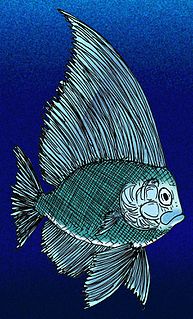 W
WAbsalomichthys velifer is an extinct, prehistoric manefish that lived during the Upper Miocene of what is now Southern California. Its dorsal fin was huge in comparison with living species.
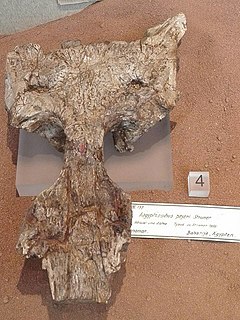 W
WAegyptosuchus is an extinct genus of aegyptosuchid eusuchian crocodyliform. This taxon was coined by Kuhn (1936) as a monotypic family-level taxon redundant with the Cretaceous genus Aegyptosuchus. Carroll (1988) classified the genus in the family Stomatosuchidae. Only one species is descript, Aegyptosuchus peyeri.
 W
WAlectrosaurus is a genus of tyrannosauroid theropod dinosaur that lived in Asia during the Late Cretaceous period, about 96-85 million years ago in the Iren Dabasu Formation and the Ialovachsk Formation. It was a medium-sized, moderately-built, ground-dwelling, bipedal carnivore, estimated at 5 to 6 m with a body shape similar to its much larger advanced relative, Tyrannosaurus. Alectrosaurus was a very fast running tyrannosauroid as indicated by the elongated hindlimbs that likely filled the niche of a pursuit predator, a trait that seems to be lost by the advanced and robust tyrannosaurids.
 W
WBactrosaurus is a genus of herbivorous dinosaur that lived in Asia during the Late Cretaceous, about 96 million years ago. The position Bactrosaurus occupies in the Cretaceous makes it one of the earliest known hadrosauroids, and although it is not known from a full skeleton, Bactrosaurus is one of the best known of these early hadrosauroids, making its discovery a significant finding.
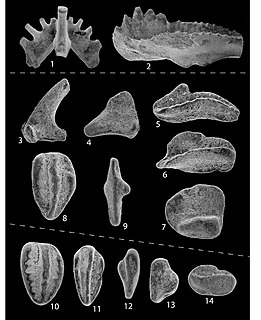 W
WCavusgnathus is an extinct genus of conodonts.
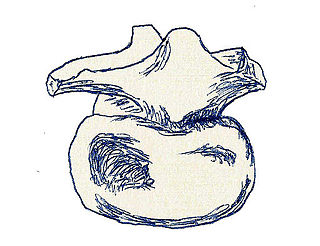 W
WCoeluroides is a small, little-known theropod dinosaur that lived during the Late Cretaceous Period in what is now India. It is known from scattered tail vertebrae discovered in the Lameta Formation. It is estimated at two meters long and perhaps thirty kilograms in weight, similar to but larger than Jubbulpuria. Coeluroides was long considered a nomen dubium because of sparse remains, but a 2004 overview of Indian theropods from the Lameta Formation found it to be probably valid. An SVP 2012 abstract considers it as a possible senior synonym of Ornithomimoides.
 W
WCompsosuchus is an extinct genus of noasaurid dinosaur originally classed as an abelisaurian. It lived during the Late Cretaceous in India.
 W
WDiscosauriscus was a small seymouriamorph which lived in what is now Central and Western Europe in the Early Permian Period. Its best fossils have been found in the Broumov and Bacov Formations of Boskovice Furrow, in the Czech Republic.
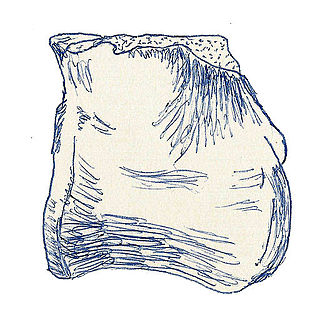 W
WDryptosauroides is the name given to a dubious genus of dinosaur from the Late Cretaceous. It was a large theropod, belonging to the Abelisauridae. It was 10 meters long and 1.5 tonnes in weight.
 W
WElectrostephanus is an extinct genus of crown wasp in the hymenopteran family Stephanidae, and is the only genus placed in the subfamily Electrostephaninae. The genus contains four described species, E. brevicornis, E. neovenatus, E. janzeni, and E. petiolatus, placed in two subgenera E. (Electrostephanus) and E. (Electrostephanodes). Electrostephanus is known from several middle Eocene fossils which have been found in Europe.
 W
WEuropolemur is a genus of adapiformes primates that lived in Europe during the middle Eocene.
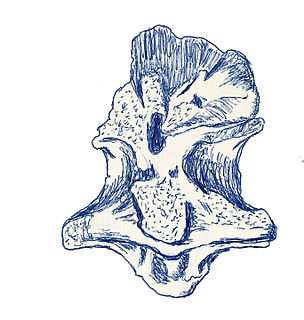 W
WIndosaurus is a genus of theropod dinosaur once living in what is now India. It lived about 69 to 66 million years ago, in the Maastrichtian division of the Late Cretaceous. It weighed roughly 700 kg (1540 lb).
 W
WIndosuchus is a genus of abelisaurid dinosaur from the Late Cretaceous Period, a theropod related to Abelisaurus. Like most theropods, Indosuchus was a bipedal carnivore. It was about 7 metres long, weighed about 1.2 tonnes, and had a crested skull, flattened on the top. Other authors estimated it to be 9.7 meters in length and 2.3 tonnes in weight.
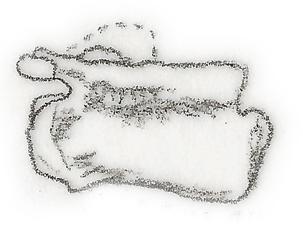 W
WJubbulpuria is the name given to a dubious genus of small dinosaur from the Late Cretaceous of India.
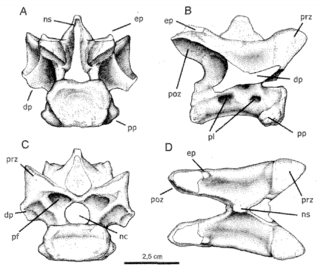 W
WLaevisuchus is a genus of abelisauroid theropod dinosaur from the Late Cretaceous. Its remains were discovered by Charles Alfred Matley near Jabalpur in Maastrichtian deposits in the Lameta Formation in India, and were named and described by paleontologists Friedrich von Huene and Matley in 1933. The type species is Laevisuchus indicus. The generic name is derived from Latin laevis, "light" and the Greek name for the Egyptian crocodile god, Soukhos. The specific name means "Indian" in Latin. It is known only from three cervical vertebrae and a dorsal vertebra. A holotype was not assigned by Huene and Matley and a lectotype has never been chosen from the syntypes. All remains except GSI K27/696 were lost; GSI K20/613 was rediscovered in 2012.
 W
WLloydolithus is a genus of trilobites from the Late Ordovician of Wales.
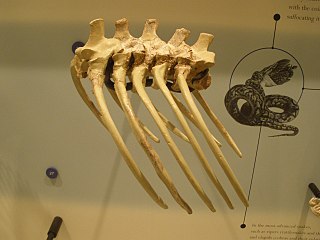 W
WMadtsoia is an extinct genus of madtsoiid snakes. It is known from the Eocene of Argentina, the Paleocene of Brazil, the Late Cretaceous (Campanian) of Spain, the Late Cretaceous of India, and the Late Cretaceous (Maastrichtian) of Madagascar and the Coniacian of Niger. Recovered vertebrae of M. pisdurensis are 1.83 centimetres (0.72 in) long and 4.35 centimetres (1.71 in) tall) and pertain to a snake that was approximately 5 metres (16 ft) long.
 W
WMongolosaurus is a genus of titanosauriform sauropod dinosaur which lived during the Early Cretaceous of China.
 W
WOnnia is a genus of trilobites from the late Ordovician of Africa, Europe, North America, and South America. Fossils have been found in Canada (Quebec), the Czech Republic, France, Morocco, Portugal, Spain, the United Kingdom, and Venezuela.
 W
WOrnithomimoides is a dubious genus of theropod dinosaur, from the Late Cretaceous period of India. Two species have been identified, though they are known only from isolated vertebrae. O. barasimlensis is known from five dorsal vertebrae, and O. mobilis from four smaller vertebrae, found at the same location. It is possible that they were very big species of abelisaur, and may have measured around 6.2 to 9 meters in length.
 W
WPinacosaurus is a genus of ankylosaurid thyreophoran dinosaur that lived in Asia during the Late Cretaceous, mainly in Mongolia and China.
 W
WPlectronoceras is the earliest known shelled cephalopod, dating to the Late Cambrian. None of the fossils are complete, and none show the apex or aperture of the shell. Approximately half of its shell was filled with septa; 7 were recorded in a 2 centimetres (0.79 in) shell. Its shell contains transverse septa separated by about half a millimetre, with a siphuncle on its concave side. Its morphology matches closely to that hypothesised for the last common ancestor of all cephalopods.
 W
WProconsul is an extinct genus of primates that existed from 28.4 to 11.608 million years ago during the Miocene epoch. Fossil remains are present in Eastern Africa including Kenya and Uganda. Four species have been classified to date: P. africanus, P. gitongai, P. major and P. meswae. The four species differ mainly in body size. Environmental reconstructions for the Early Miocene Proconsul sites are still tentative and range from forested environments to more open, arid grasslands.
 W
WProconsul africanus is an ape which lived from about 23 to 14 million years ago during the Miocene epoch. It was a fruit eater and had a brain larger than a monkey, although probably not as large as a modern ape.
 W
WSerbelodon is an extinct genus of proboscidean. It had tusks and a trunk. It lived in North America during the Miocene Epoch, and it was closely related to Amebelodon.
 W
WStanocephalosaurus is an extinct genus of large-sized temnospondyl amphibians living through the early to mid Triassic. The etymology of its name most likely came from its long narrow skull when compared to other temnospondyls. Stanocephalosaurus lived an aquatic lifestyle, occpying rivers, lakes, swamps, and shores, with some species even living in salt lakes. There are currently three recognized species and another that needs further material to establish its legitimacy. The three known species are Stanocephalosaurus pronus from the Middle Triassic in Tanzania, Stanocephalosaurus amenasensis from the Lower Triassic in Algeria, and Stanocephalosaurus birdi, from the middle Triassic in Arizona. Stanocephalosaurus rajareddyi from the Middle Triassic in central India needs further evidence in order to establish its relationship among other Stanocephalosaurs. Like other temnospondyls, Stanocephalosaurus was an aquatic carnivore. Evidence of multiple species discovered in a wide range of localities proves that Stanocephalosaurus were present all across Pangea throughout the early to mid Triassic.
 W
WThylacosmilus is an extinct genus of saber-toothed metatherian mammals that inhabited South America from the Late Miocene to Pliocene epochs. Though Thylacosmilus looks similar to the "saber-toothed cats", it was not a felid, like the well-known North American Smilodon, but a sparassodont, a group closely related to marsupials, and only superficially resembled other saber-toothed mammals due to convergent evolution. A 2005 study found that the bite forces of Thylacosmilus and Smilodon were low, which indicates the killing-techniques of saber-toothed animals differed from those of extant species. Remains of Thylacosmilus have been found primarily in Catamarca, Entre Ríos, and La Pampa Provinces in northern Argentina.
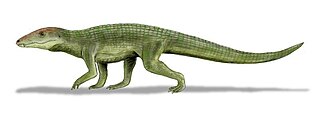 W
WUruguaysuchus is an extinct genus of crocodylomorphs from the Late Cretaceous Guichón Formation of Uruguay. It was related to Simosuchus and Malawisuchus. It was of small to moderate size reaching an estimated length of 120 centimetres (3.9 ft).